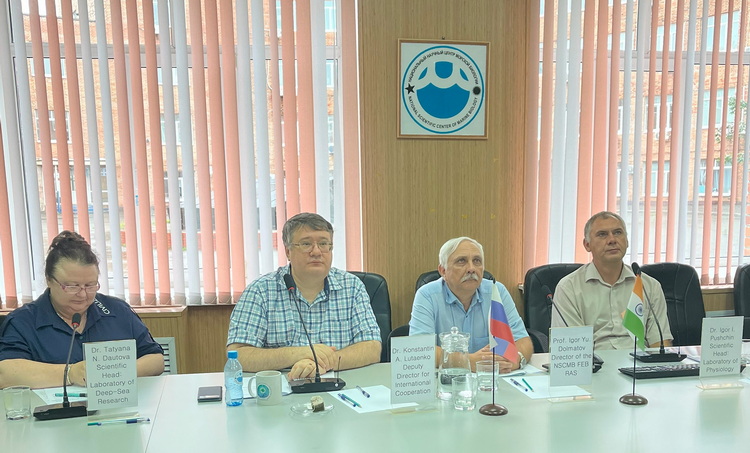On the 23rd of August, the joint online-conference with the Indian Institute of Science Education and Research, Kolkata (IISER-Kolkata) and Satyabama Institute of Science and Technology (SIST) was held in A.V. Zhirmunsky National Scientific Center of Marine Biology FEB RAS, Vladivostok.
This online-conference was aimed at the mutual familiarization with the activities of these scientific organizations and determination of scientific directions for the further strengthening of cooperation.
From the Russian side, the NSCMB FEB RAS was represented by the Director of Igor. Yu. Dolmatov, Corr. Member of RAS, Deputy Director for International Cooperation Ph.D. Konstantin A. Lutaenko, the Director of the Scientific-Educational Center “Primorsky Aquarium”, Branch of the NSCMB FEB RAS, Olga G. Shevchenko, the Scientific Head of the Laboratory of Deep-Sea Research Ph.D. Tatyana N. Dautova, the Scientific Head of the Laboratory of Physiology Ph.D. Igor I. Puschin and Communication Specialist of International Cooperation Department in “Primorsky Aquarium” Natalia V. Miroshnikova.

The Indian side was represented by Prof. Punyasloke Bhadury, Dr. Anwesha Ghosh, Mr. Arkaprava Mandal, Dr. Amit Kumar, Mrs. Nirupama Saini and Mr. Yash.
The webinar was started with greetings of the Heads of these organizations: Prof. Punyasloke Bhadury and Directors – Igor Yu. Dolmatov and Olga G. Shevchenko.
The conference consisted of two sessions, during which the participants of both sides made short reports-presentations. The Deputy Director for International Cooperation of the Center Dr. Konstantin A. Lutaenko presented the report “NSCMB FEB RAS and its activities”. His report included information on research conducted in the NSCMB FEB RAS, the basic directions of the work, international scientific activities, and emphasized the important scientific achievements of the Center.
Prof. Punyasloke Bhadury submitted the report “IISER Kolkata and Centre For Excellence in Blue Economy – the genesis”.
Indian Institutes of Science Education and Research (IISERs) were established as autonomous institutes for higher education by then Ministry of Human Resource Development (now Ministry of Education), Government of India, to promote high quality education and research in basic sciences. The first two institutes, under this initiative, were IISER Kolkata (IISER-K) and IISER Pune in 2006, followed by IISER Mohali in 2007, and IISER Bhopal and IISER Thiruvananthapuram in 2008, IISER Tirupati in 2015, and IISER Berhampur in 2016.
The Institute has flexible academic programs and possesses a modern research base. At the present time, it includes 7 academic departments (Biological Sciences, Chemical Sciences, Earth Sciences, Mathematics & Statistics, Physical Sciences, Computational and Data Sciences and Humanities and Social Sciences) and five Centers for excellence: Center for Excellence in Space Sciences India supported by the Ministry of Education, National Centre for High Pressure Studies, supported by the Ministry of Earth Sciences, “Centre for Advanced Functional Materials (CAFM)” supported by the Institute; and two interdisciplinary Centers created with the Institute initiative are "Centre for Climate and Environmental Studies" and "Centre for Large-Scale Computing".
The IISER Institute has established partnerships with various national and international universities/institutes for student and faculty exchange.
The Head of the Laboratory of Deep-Sea Research in the NSCMB FEB RAS Tatyana N. Dautova presented the report “Corals as indicators of the vulnerable marine ecosystems —state of knowledge and perspectives” and also showed the video-film “Comprehensive studies of the ecosystems of the southern part of the Imperial Ridge, Pacific Ocean”, which was made in 2021 during the cruise 94 of the R/V “Academician Lavrentiev”.
Dr. Anwesha Ghosh submitted his report “Environmental emergence of antimicrobial resistance: a case study in the Sundarbans mangroves”. The Sundarbans is the largest mangrove forest on earth, which is located in the Ganges delta in India and Bangladesh. The part of the Sundarbans far from the ocean is covered by seasonally flooded freshwater swamp forests. The Sundarbans cover an area of 10,000 km², of which 6,000 km² are in Bangladesh.
The Head of the Laboratory of Physiology in the NSCMB FEB RAS Igor I. Puschin presented the report “Past and present-day IMB-NSCMB studies in physiology of vision”.
Mr. Arkaprava Mandal started the second session with the report “Mapping the ecosystem health of the mangrove ecosystem from the northeast coastal Bay of Bengal: applicability of benthic foraminifera coenosis”. N.V. Miroshnikova told about Primorsky Aquarium: “Primorsky Aquarium: Scientific Research and Environmental Education”
During this meeting, Dr. Amit Kumar from SIST presented the report “Impact of ocean acidification on seaweed physiology and possible implications on coastal food chain”. Mrs. Nirupama Saini informed to participants about “Interaction between microbes and microplastics in northeast coastal Bay of Bengal: attachment to degradation”. Mr. Yash from the Centre for Excellence in Blue Economy, IISER-Kolkata ended the second session with his report “Implication of mangrove leaf litter in the aquaculture ponds of Sundarbans- towards sustainable ecological aspects of blue economy”.
The bilateral India-Russia online conference was held on a friendly, positive note, during which participants from both sides agreed to hold soon a more detailed online conference to strengthen future cooperation.
In conclusion, Prof. Punyasloke Bhadury from IISER-Kolkata invited Russian colleagues to visit the conference, which will take place in autumn 2024, in Kolkata, India.
The Indian-Russian online-meeting was conducted within Memorandum of Understanding, which was signed in the beginning of December 2021.